#infanta urraca
Photo
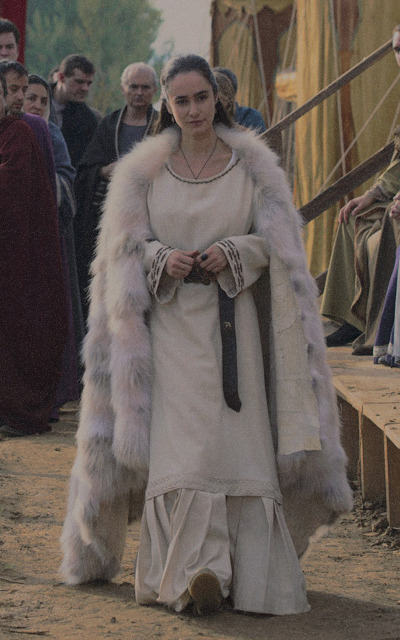

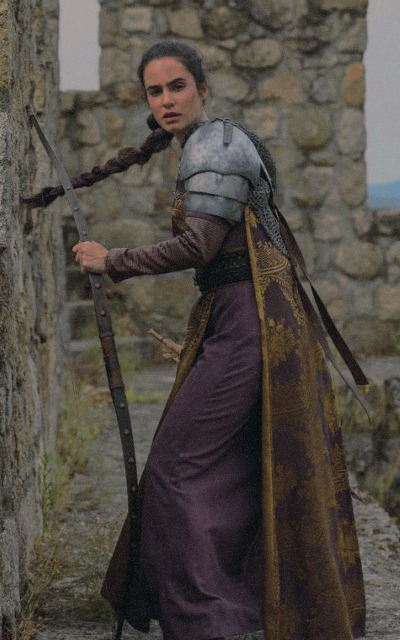



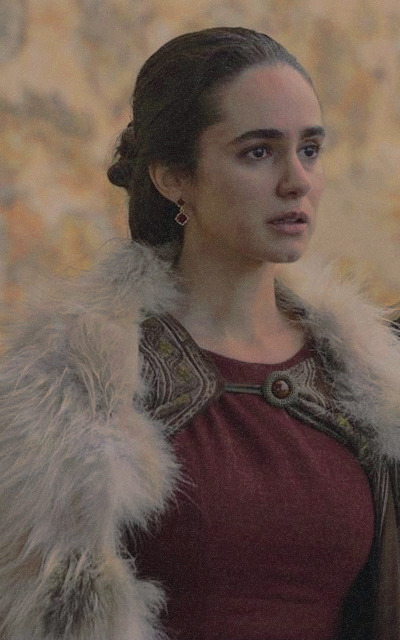
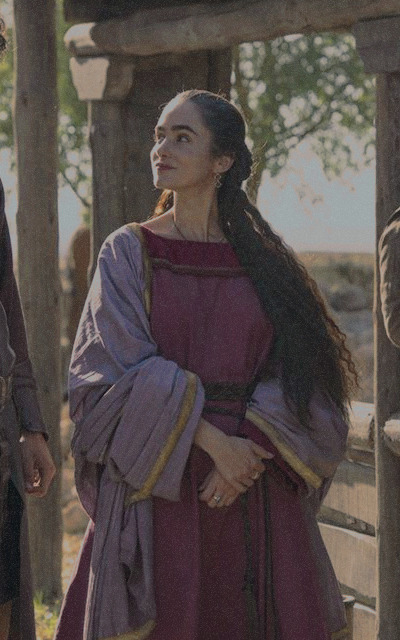
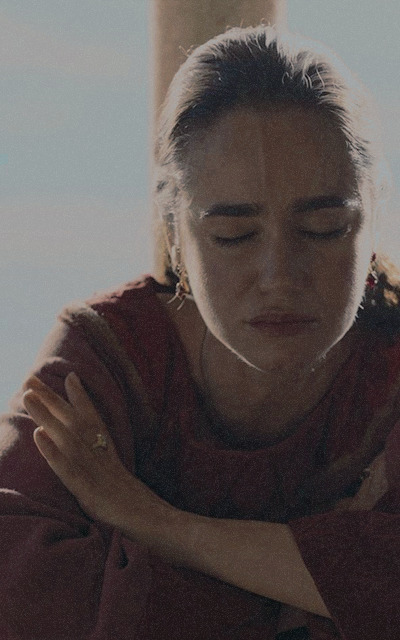
+ 9 avatars Alicia Sanz (1-9) LIEN IMGBOX
#alicia sanz#alicia sanz avatar#alicia sanz avatars#400x640#200x320#avatar#avatars#el cid#el cid avatar#el cid avatars#infanta urraca#infanta urraca avatar#infanta urraca avatars
12 notes
·
View notes
Text

Berenguela de Barcelona
She was a very beautiful and extremely graceful young girl who loved chastity and truth and all God-fearing people.
Berenguela was the daughter of Ramon Berenguer III, Count of Barcelona and his third wife Dolça I de Gévaudaun, Countess of Provence. Although her date of birth is unknown, the sources place it between 1108 and 1116. It is known that Berenguela had a good relationship with her older sister, María de Osona, who was the daughter of the first marriage of her father with María Rodríguez, the daughter of El Cid Campeador.
In 1128 Berenguela married Alfonso VII, King of León, Castile and Galicia. She becoming the first queen of the newly reigning dynasty of the House of Ivrea. In 1135, Alfonso VII was crowned “Emperor of Spain” (Imperator totius Hispaniae) in the Cathedral of León. The imperial couple had seven children, of whom Sancho III was King of Castile and Fernando II King of León. The daughters, Constanza and Sancha, became Queens consorts of France and Navarre.
Historians who have dedicated to studying her life consider that Berenguela de Barcelona was one of the characters who deserves a privileged position in the history of Spain. She actively participated in political life and was patroness of the arts. She accompanied her husband in the battles, stopped the uprising in Asturias and heroically resisted the besieged of Toledo by the Muslims. She also introduced a taste for Provencal troubadours to the kingdom, supported writers who narrated the exploits of El Cid and encouraged pilgrimages to Santiago de Compostela, where she was buried in 1149.

Berenguela nació en el prestigioso y rico condado de Barcelona como hija del conde Ramón Berenguer III y de su segunda esposa Dulce de Provenza. La joven barcelonesa destacó por su inteligencia y gran belleza, llegando su fama hasta la corte del rey Alfonso VII de Léon, Castilla y Galicia, hijo de la legendaria reina Urraca. Al parecer fue un noble, Armengol de Urgel, quien le facilitó los trámites para entrar en contacto con los condes de Barcelona. El rey de León tenía poco más de veinte años y no estaba casado, ni siquiera había ninguna candidatura seria para un matrimonio, que tarde o temprano tendría que celebrarse.
Una vez prometida al rey Alfonso VII, Berenguela de Barcelona emprendió un largo viaje. Desde Barcelona hasta la corte de su futuro marido, debía cruzar los dominios del rey aragonés Alfonso el Batallador, quien estaba en disputa con Castilla por cuestiones territoriales y fronterizas. Para evitarlo, Berenguela y su comitiva tuvieron que hacer parte del viaje por el sur de Francia, llegar hasta el Golfo de Vizcaya y fletar unas barcazas que, bordeando la costa cantábrica, les permitieran desembarcar en un puerto controlado por los leoneses.
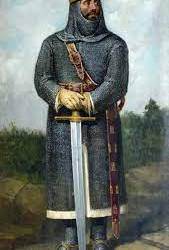
A finales de 1128 o enero de 1129, los prometidos contraían matrimonio en la villa de Saldaña. Con motivo de las celebraciones de los esponsales, que duraron varios días, se dice que tuvo lugar la primera corrida de toros celebrada en la Península. La pareja imperial tuvo siete hijos, destacándose Sancho III de Castilla y Fernando II de León. La joven reina forjó una gran amistad con su cuñada la infanta Sancha Raimúndez, llegando a ser ambas las principales consejeras de Alfonso VII. Berenguela participó en la política de forma activa, fue la principal responsable de apagar la rebelión del conde de Asturias Gonzalo Peláez y acompañó a su esposo a la guerra en muchas ocasiones, participando así de sus victorias.
En 1135 tuvo lugar la coronación de Alfonso VII como Imperator totius Hispaniae en la catedral de León, gran parte de los nobles presentes en el acto habían llegado gracias a los contactos de la reina y su familia; así su hermano Ramón Berenguer IV, Armengol de Urgel, el conde Alfonso Jordán de Tolosa, el de Montpellier, el duque de Gascuña, el de Foix y otros grandes señores del Sur de Francia. A ella, entonces, cupo el gran honor de ser la Emperatriz consorte de Hispania.

Nos dice la crónica de Alfonso VII que en 1139 la reina Berenguela fue la responsable de una heroica resistencia en Toledo. Habiendo partido su marido al sitio del castillo de Aurelia, encargó a su esposa la defensa de la ciudad. Pero la campaña se alargó demasiado y Toledo fue sitiada por las tropas musulmanas. Berenguela reunió un pequeño ejército, pero, consciente de su inferioridad, decidió intentar una jugada diplomática para tratar de evitar la lucha. Indignada por la destrucción de la torre de San Servando, cercana a la ciudad, Berenguela envió un mensajero con una carta al campo enemigo que decía lo siguiente:
"¿No conocéis que es mengua de caballeros y capitanes esforzados acometer a una mujer indefensa cuando tan cerca os espera el emperador? Si quereis pelear id a Aurelia y allí podréis acreditar que sois valientes, como aquí dejar demostrado que sois hombres de honor si os retiráis".
La reina Berenguela apareció además sentada sobre un trono real en una de las torres, rodeada de sus doncellas, que cantaban con tímpanos, cítaras, címbalos y salterios. Los musulmanes quedaron impresionados por la nobleza de la reina y levantaron inmediatamente el cerco, marchando a luchar contra Alfonso. Cuando el alcaide de Toledo, Nuño Alfonso, entró victorioso en la ciudad portando las cabezas de los emires de Sevilla y Córdoba, las mandó colgar de las torres del alcázar, pero la reina se apiadó, ordenando que las embalsamaran y enviaran a sus viudas en cofres de oro. Una torre en Toledo (la Torre de la Reina) recuerda la gesta de la reina Berenguela.
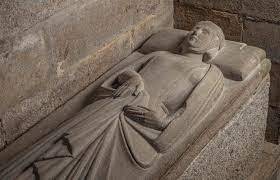
Berenguela es recordada como una prudente reina que sacrificó sus sentimientos dando prioridad a los intereses de la corona. Cuando de las infidelidades de su esposo con la noble asturiana Gontrodo Pérez nació una hija, doña Urraca, la reina perdonó a su esposo y quiso ganárselo mediante el cariño. Aún más, cuando Urraca casó con el rey de Navarra García el Restaurador, la reina Berenguela se encargó de preparar los esponsales con gran pompa y asistió, dando gran realce a la ceremonia. Mujer culta, Berenguela fue una gran mecenas y amante de las artes, a ella se debe el impulso de la poesía provenzal en el reino, apoyó a escritores que narraban las hazañas del Cid y fomentó el peregrinaje a Santiago de Compostela, donde fue enterrada. Su muerte fue muy lamentada, tanto que, según los historiadores de la época, el año 1149 fue usado en los documentos como punto de partida para fechar los acontecimientos, bajo la fórmula "año en que falleció la señora emperatriz".
#Berenguela de Barcelona#Berenguela Berenguer#Berengaria of Barcelona#Spanish history#women in history#Alfonso VII
25 notes
·
View notes
Text






✠︎ʜɪꜱᴛᴏʀɪᴄᴀʟ ꜰɪɢᴜʀᴇꜱ x ᴍᴏᴅᴇʀɴ ᴀᴇꜱᴛʜᴇᴛɪᴄꜱ✠︎
• Countess Elizabeth Báthory de Ecsed, (7 August 1560 – 21 August 1614), was a Hungarian noblewoman and "purported serial killer" from the family of Báthory, who owned land in the Kingdom of Hungary.
• Urraca of Zamora (1033/34 – 1101) was a Leónese infanta, one of the five children of Ferdinand I the Great, who received the city of Zamora as her inheritance and exercised palatine authority in it. Her story was romanticized in the cantar de gesta called the Cantar de Mio Cid, and Robert Southey's Chronicle of the Cid.
• Catherine de’ Medici, was queen consort of Henry II of France and subsequently regent of France (1560–74), who was one of the most influential personalities of the Catholic–Huguenot wars. Three of her sons were kings of France: Francis II, Charles IX, and Henry III.
• Archduchess Margaret of Austria was Governor of the Habsburg Netherlands from 1507 to 1515 and again from 1519 to 1530. She was the first of many female regents in the Netherlands.
• Jasper Tudor, Duke of Bedford and Earl of Pembroke also called Jasper of Hatfield, was the uncle of King Henry VII of England and a leading architect of his nephew's successful accession to the throne in 1485. He was from the noble Tudor family of Penmynydd in North Wales.
• Mary was the eldest of three surviving children of Thomas and Elizabeth Boleyn. Much like her siblings, Anne and George, many details regarding Mary’s formative years remain something of a mystery, and we cannot be exactly certain in which order the siblings were born. We can, however, be fairly certain that the children were born between 1500 and 1507, at the Boleyn estate of Blickling Hall, in Norfolk.
#perioddramaedit#history#edit#history edit#lana del rey#the tudors#jasper tudor#thomas doherty#mary boleyn#samara weaving#catherine de medici#isolda dychauk#urraca de zamora#urraca of zamora#jessica de gouw#elizabeth bathory#jessica chastain#margaret of austria#fancast#modern edit#modern aesthetic#modern au#aesthetic#historical figures#modern history au#modern moodboard#english history#french history#german history#hungarian history
68 notes
·
View notes
Text
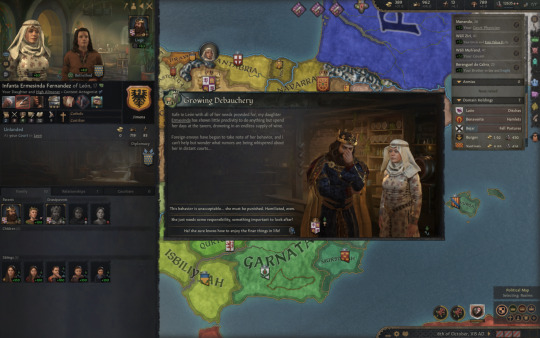
King Fernando's eldest daughter, Infanta Ermesinda Fernandez of Leon has been spending most of her days at the tavern, drowning in an endless supply of wine. To prevent her from following in the footsteps of her grandfather, the late King Alfonso who died early from over-drinking, King Fernando chooses to punish and humiliate her behaviour.

King Fernando's best friend and spymaster, Duke Pere Ramon 'the Impaler' of Barcelona, who is now 71 years of age, has taken to the life of a poet composing all manner of poems. Duke Pere Ramon seems to have a composed a particular piece that deals with feelings of sorrow and loss and publicly dedicated it to King Fernando, to which King Fernando shows his appreciation for it.
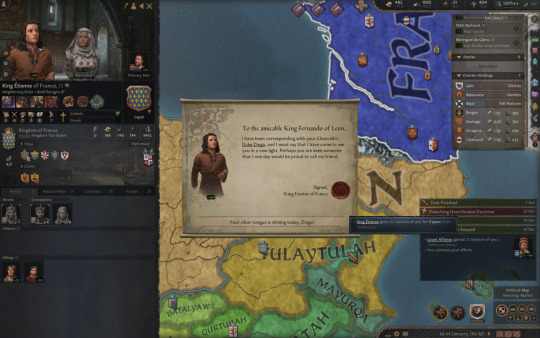
King Fernando's nephew and Chancellor Duke Diego (who is the son of El Cid) has performed rather admirably by convincing King Etienne of France to see King Fernando in a new light and even consider calling upon as a friend.
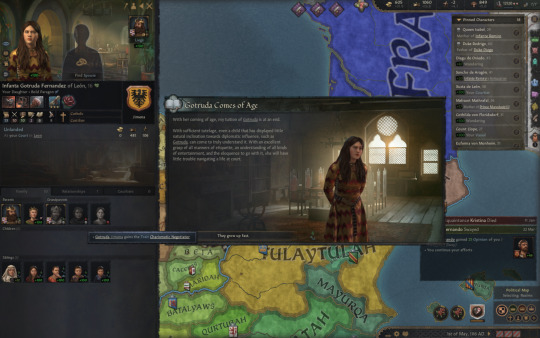

Finally, King Fernando's 2nd eldest daughter, Infanta Gotruda Fernandez of Leon has come of age and acquired the 3rd highest level Diplomacy trait, Charismatic Negotiator. We marry her matrilineally to Diego the King of Thieves so that we can acquire ourselves a high-stat courtier. Since Diego has 32 Intrigue skill points, we can keep him as our backup spymaster for when Duke Pere Ramon dies.

King Fernando's Court Tutor, Infanta Urraca wants to read our player heir, Infante Jaime her masterpiece on the art of Diplomacy, but Infante Jaime complains that he has heard this dreary book a thousand times. King Fernando suggests to Infanta Urraca to perhaps let the lad learn something else..
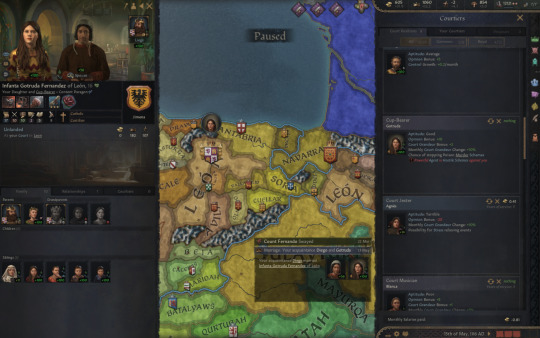
As part of our process of dishing out court positions to Jimena family members so that we can take advantage of that Dynasty Legacy that makes it so that dynasty members work in court positions for free, we discover that Infanta Gotruda makes a Good Cup-Bearer.

A snap-shot in time of our King Fernando and the Kingdom of Leon on 15th of May 1116 AD.
3 notes
·
View notes
Text
I know this show isn't even airing anymore but I'm watching it now and there is something that just stuck to me and I need to talk about it. I just... Hate what they did to Orduño's character in 1x04(?), and by extension, Jimena and Ruy's plotline.
Like, the first thing we see of Orduño in the series is him mistreating Ruy, if I remember correctly because of his father/lowborn status + him getting too close to Jimena (Ordoño's betrothed). Since then we have many scenes showing that he's constantly trying to get his father's approval or Jimena's affections, is loyal to the just prince who has taken him under his wing no matter what (being Alfonso the only one who actually listens to him), and the only times his efforts are acknowledged are when he is merely useful as a political pawn. Despite his first impression, the path he had been taking is quite easy to relate or sympathize. Damn, I was rooting for him much more than I have ever rooted for Ruy, who is supposed to be the main character (but then again almost everyone is more interesting than Ruy shhhh-)
But then the drunken scene with Jimena happens. There was just so much potential in there! To deepen even more those characters, their relationship and the drama! Imagine, Orduño sees Jimena's handkerchief with Ruy's blood in it and starts to cry, asking out aloud things like "what Ruy has that he doesn't, why nothing he does is ever enough" — in such a display of doubt / sensitivity / vulnerability that he would never allow himself to show in front of his betrothed when sober. I think it would catch Jimena so off guard, it would be very interesting to see how their relationships and characters would develop from this interaction/confession — something that could even, maybe, make Jimena doubt about her own feelings, creating some drama to this storyline, which, to be honest, has been quite bland since the beginning. Three birds with one stone! So simple, cute, and effective!
But no, let's make Orduño assault Jimena, because he's one of the villains, we need to remind the public that he's a bad guy, lest they forget about it!!!! It'll be useful when Ruy supports Sancho, so that people don't root for Alfonso who is supported by this evil man 😴 we can't have ""villain"" figures unless they are plain characters and try to have their way with an innocent good girl at some point after all.
Though there is something else that adds another layer to this problem and makes my blood boil even more. While all of this is happening, Ruy is sleeping with one of the Emir's daughters. Can you see what is being implied here, whether it is accidental or not? Ruy kills people, wins a battle, and is rewarded with a passionate night with a random noble lady who had been showing interest in him because he has the power of being the main character, Jimena not even a second thought. At the same time, however, Jimena tries to prevent her father from abusing her mother, seeks infanta Urraca to protect her friend who is being sexually assaulted, stands loyal to her affections for Ruy, and is being punished for it by none other than her own betrothed! Just how disturbing is that!?
If there is someone out of the two of them who actually could/deserves to have some quality time with a romantic prospect, it is Jimena with Orduño, the couple that in fact has a right to behave romantically towards each other, by society's standards. Ruy is just the crown Prince's squire, normally that noblewoman shouldn't even look his way, no wonder it seems next episode it will generate some problems for them (judging by the synopsis, haven't watched). I don't know, it all just sounds like a cheap isekai harem anime bullshit to me. All the feminist undertone they were trying to create in Urraca's storyline was just thrown in the trash.
Anyway, I'm still enjoying the show, I suppose, despite all of this. They also could have used more Urraca though. Not call this show El Cid, since Ruy is almost a side character in what was supposed to be his own show. Focus on what matters, which is the court intrigue / politics. Stuff like that.
#el cid#el cid amazon prime#el cid 2020#orduno el cid#orduño el cid#jimena el cid#ruy el cid#venting#el cid 1x04
5 notes
·
View notes
Text
history is such a rabbit hole, like for completely unimportant reasons I was looking at infantas of Portugal and got hooked right away on Teresa, first king Afonso Henriques’ second daughter (and his faaaaaaaaaaavourite and i can totally see why)
so when Afonso got injured in 1169 (haha nice), his son Sancho took over the regency, and in 1172 Afonso considered a succession via the female line with Teresa in case Sancho didn’t have kids. Then in 1173 both Sancho and Teresa became co-regents AND co-heirs. In practical terms Teresa looked after the administration of the kingdom while Sancho handled the military side of things
Teresa’s older sister Urraca married the king of León, but because Teresa was so close to the throne, her marriage with an Iberian noble was out of the question in order to protect the kingdom’s independence (Portugal was literally less than 40 years old at this point)
enter the proposal from Philip I, Count of Flanders! She was like 32/33 by this point and even though it wasn’t an Iberian lord, she still had to agree that Sancho would be the sole heir before she married. Once that was out of the way she sailed up to Flanders and apparently got attacked by pirates who took a lot of the dowry she had, yet still had enough that people marvelled at it and it financed Philip’s war against France for a few more years (when I tell you Afonso Henriques amassed a huge treasure during his reign... he was a very lucrative hostage as his son-in-law Ferdinand II of León found out)
Anyway no kids were born (also for some reason she was known as Mathilde over there) and Philip died in some crusade, so the county actually fell to his sister Margaret and her husband Baldwin, but Teresa was like yeah but what if....I keep it? Anyway in the end they reached a deal and the sister and husband got it but Teresa still had influence over it bc she had a bunch of dower lands in the south
and also a bunch of portuguese people had gone with her to flanders, most of them merchants which is not new BUT i didn’t know the commercial link went back to the 12th century, ya know, so that’s cool
also cool is that her brother Sancho had a policy of populating remote areas of Portugal (his kingly nickname was “The Populator” due to this and also the number of kids he had) and guess where most of the people who settled those lands came from? that’s right, Flanders and Burgundy
anyway Teresa married Odo III the duke of burgundy (it all comes full circle) but no kids again so the marriage was dissolved. it’s also said part of the reason for the dissolution was that Teresa sided with Ingeborg, who was Philip II of France’s wife, while her husband sided with Philip.
anyway it may have been due to this that Ingeborg introduced Berengária, Teresa’s niece and Sancho’s daughter, to her brother Valdemar of Denmark. Also Teresa’s nephew Fernando, who had travelled with his sister Berengária, married Joan (the granddaughter of Margaret and Baldwin) and became count of Flanders but spent most of that time as a french prisoner and that’s cool. a cool start
anyway teresa drowned, which isn’t nice, but her life sure was interesting and makes for quite the incoherent post
#lunie blabbers#just me rambling over history#tell me how i'm supposed to make a coherent post when everything is connected#and this is just after reading about one (ONE!) princess#that flanders connection though
6 notes
·
View notes
Text
Urraca I de León
(?, hacia 1079 - Saldaña, Palencia, 1126) Reina de León y Castilla (1109-1126). Es una de las personalidades más polémicas de la Edad Media hispana, pues su reinado coincidió con una de las épocas más tormentosas del incipiente reino de Castilla. Vilipendiada por unos y elevada a los altares por otros, los diferentes juicios de valor efectuados sobre su figura, así como la escasez de fuentes, hacen que el acercamiento objetivo a su biografía sea complejo y delicado, como también lo resulta el calibrar su verdadera aportación a la Edad Media hispana.
Urraca fue la hija primogénita de Alfonso VI, y de la segunda esposa de éste, la reina Constanza de Borgoña. Debió de nacer hacia el año 1079 y, en principio, se desconocen más datos sobre su infancia; es lógico suponer que no tuviera residencia fija, sino que acompañase a la corte itinerante de su padre, el rey Alfonso, y que estuviese presente en la toma de Toledo (1085), verdadero hito de la época por su significado en la reconquista peninsular.

Hacia el año 1090, cuando la infanta alcanzó edad núbil, Alfonso VI, en virtud de las alianzas existentes entre Castilla y el condado de Borgoña, aceptó casarla con el titular del condado galo, Raimundo de Tolosa. Los esponsales debieron de celebrarse ese mismo año, pues Alfonso VI obsequió a los recientes cónyuges con los condados de Portugal y Galicia; para poder llevar a cabo esta donación, Alfonso VI debió esperar al fallecimiento de su hermano García de Galicia, ocurrido aproximadamente en la misma fecha.
En ese momento comenzó la estrecha relación entre doña Urraca y Galicia, primero por la vinculación titulada al territorio y, en segundo lugar y mucho más importante, por la entrada en escena de un personaje clave en el reino castellano de la época: Diego Gelmírez, pariente del obispo de Santiago de Compostela, Diego Peláez. La admiración de Gelmírez por la orden de Cluny le acercó al conde Raimundo, que nombró a Gelmírez, entonces vicario de la diócesis compostelana, su secretario y notario personal y de su casa. Por lo que respecta a la infanta Urraca, esta primer fase de su vida, aproximadamente hasta el año 1106, se caracterizó por cierto anonimato (no es demasiado mencionada en crónicas y documentos de la época), y por su supuesta dedicación al cuidado de sus dos hijos: doña Sancha y don Alfonso, el que iba a ser futuro heredero del trono castellano con el nombre de Alfonso VII.
La sucesión de Alfonso VI
La situación cambió repentinamente a partir de 1107, fecha en la que falleció el conde Raimundo. Urraca pasó a convertirse en firme candidata a hacerse con el trono en tanto su hijo Alfonso alcanzaba la mayoría de edad, toda vez que los cinco matrimonios legales de Alfonso VI no habían deparado un heredero varón. Eso sí, hasta el último momento, Alfonso VI estuvo tentado de nombrar heredero al infante Sancho, más conocido como Sanchico, hijo de una de sus concubinas, la princesa Isabel, que no es otra sino la nimia pulchra Zaida, protagonista de los romances, hija de Abul-Qasin Muhammad II, reyezuelo taifa de Sevilla. Pero este infante falleció siendo un niño, el 30 de mayo de 1108, a manos de los musulmanes victoriosos en la batalla de Uclés. El dolor de esta muerte aceleró la propia de Alfonso VI, acontecida al año siguiente.
Antes de morir, quedaba por finiquitar una cuestión: ¿convenía a doña Urraca contraer nuevo matrimonio? La nobleza castellano-leonesa comenzó a mover los hilos para que el candidato fuese Gómez González, conde de Candespina, uno de los más poderosos señores feudales de Castilla. Alfonso VI convocó a todos los prelados del reino a un consejo y decidió casarla con el monarca aragonés, Alfonso el Batallador, ceremonia que se celebró en el castillo de Muñón poco antes del fallecimiento de Alfonso VI, en 1109. Parece que la desconfianza de su nobleza cegó al monarca castellano, ya que, por no someter al reino a las luchas aristocráticas, acabó por involucrar en los asuntos castellanos al que era entonces el mayor dominador territorial de la península: Alfonso, monarca de Aragón, de Navarra y ahora rey consorte de Castilla.
A pesar de esta decisión, Alfonso VI no pudo evitar totalmente las luchas aristocráticas. Es bastante probable (sobre todo visto el devenir posterior del enlace) que fuese verdadera la negativa de la propia Urraca a casar con el monarca aragonés, y, por la misma senda de la sospecha, que su pasión hacia el conde de Candespina, Gómez González, fuera asimismo cierta. Alrededor del conde de Candespina, que contaba con el apoyo del arzobispo de Toledo, don Bernardo (arma importantísima de la Iglesia, dada la consaguinidad de los cónyuges), se conformó el primer grupo de poder en la corte castellana. El segundo fue encabezado por los enemigos de Gómez González, sobre todo el antiguo ayo de la reina Urraca, Pedro Ansúrez, a quien las sospechas señalan como el factótum de que saliese a relucir el nombre de Alfonso el Batallador como esposo de la reina viuda. Un tercer personaje de importancia, que desempeñó un papel fundamental, fue Pedro Froilaz, conde de Traba, ayo del príncipe Alfonso, quien se criaba en tierras gallegas (en Castrelo de Miño), ajeno en principio a todas estas luchas.
Una vez celebrado el enlace, en octubre de 1109, Urraca acompañó a Alfonso hacia tierras aragonesas, donde iba a ser recibida con los honores que merecía. Pero rápidamente, ante la noticia del fallecimiento de Alfonso VI, ambos regresaron de nuevo a Castilla para hacerse cargo de la monarquía. Aunque existían temores de cómo recibirían los castellanos a Alfonso, todos los grandes señores respetaron el luto por el finado monarca y la última decisión de éste, por lo que Alfonso y Urraca pudieron hacerse cargo de todos los enclaves importantes, así como iniciar una política de repoblación en diversos lugares, en especial Belorado, Almazán y Soria.
A pesar de ello, pronto surgieron las primeras desavenencias en el matrimonio, provocadas por los temores de Alfonso el Batallador a que la existencia de un parentesco demasiado estrecho entre él y su esposa (eran primos segundos) hiciese nulo el matrimonio. Para evitar cualquier acción contraria a sus intereses, Alfonso, ante el malestar de Urraca y de buena parte de la aristocracia, no dudó en entregar las fortalezas castellanas más importantes a aragoneses de su séquito, leales a su causa.
Esta decisión fue la que encendió la mecha de la secesión gallega. El conde de Traba, al tener noticia de lo sucedido, se apresuró a proclamar al pequeño Alfonso VII como rey independiente de Galicia. Alfonso el Batallador montó en cólera y se apresuró a dirigir las milicias aragonesas hacia el territorio rebelde. Ante esta noticia, los señores feudales de Galicia comenzaron a reclutar tropas señoriales, en especial Pedro Arias, señor de Deza, su hijo Arias Pérez, y el propio arcediano de Compostela, Gelmírez, que comenzó aquí su intrigante carrera política.
En este punto, las fuentes se contradicen: para la Historia Compostelana, Alfonso el Batallador supo ganarse al concejo de Lugo y al castillo de Monterroso (contrarios al despótico gobierno señorial de Gelmírez y el conde de Traba), desde donde dirigió ataques a los rebeldes que les hicieron desistir de este intento; para el Anónimo de Sahagún, las tropas gallegas lograron que Alfonso claudicase y entablara negociaciones con los nobles gallegos. En cualquier caso, hacia el año 1110, Pedro Froilaz, conde de Traba, ya era muy consciente de que la proclamación de Galicia como reino independiente debería esperar una mejor ocasión. Y, por idéntico motivo, Alfonso el Batallador supo que, mientras el infante Alfonso siguiese en manos del conde de Traba, Galicia sería un grave problema para sus intereses hegemónicos en la política peninsular.
Las desavenencias matrimoniales
A partir de este momento fue cuando verdaderamente tomó relevancia el papel de la reina Urraca tanto en su vertiente política, como en la vertiente íntima de sus problemas con Alfonso el Batallador. De nuevo existen sospechas razonables de que fuese la propia reina, siempre apoyada por el conde de Candespina y por el arzobispo de Toledo, quien forzase el envío al papa Pascual II de las pistas necesarias para declarar nulo el matrimonio por incestuoso. A principios de 1110 la reina y el rey discutieron tan gravemente que doña Urraca optó por abandonar León y refugiarse en el monasterio de Sahagún, en espera de que las bulas pontificias llegasen. Y, entre que llegaban y no, Urraca mantuvo relaciones con el conde de Candespina, Gómez González, con quien tuvo un hijo.
Tal vez ello explique la reacción de Alfonso el Batallador: en septiembre de 1110, después de una breve reconciliación con la reina, sus oficiales la prendieron en Sahagún y la encerraron en la fortaleza aragonesa de El Castellar (Teruel). El siguiente paso fue formar un impresionante ejército (formado por aragoneses en su mayor parte, pero también mercenarios navarros, normandos, franceses e incluso musulmanes), con el objetivo de arrasar Castilla y demostrar quién era el rey. Alfonso, haciendo honor a su apelativo, tomó todas las plazas fuertes del reino, incluyendo Toledo (donde depuso al arzobispo don Bernardo), Sahagún (donde hizo lo propio con el abad), Burgos, Palencia, Osma y Orense.
Ante esta situación, el conde de Candespina encabezó la resistencia castellana y envió al castillo turolense donde se hallaba encerrada Urraca a sus dos hombres de confianza, Pedro de Lara y Gómez Salvadores, para tratar de liberarla, cosa que lograron. Pero, antes de que Urraca pudiese tomar las riendas de Castilla en contra de su esposo, recibió una noticia peor: los nobles gallegos enemigos del conde de Traba, en connivencia con Gelmírez, habían sitiado Castrelo de Miño y secuestrado a su hijo, el príncipe Alfonso.
Por si no hubiera ya demasiados intereses en el conflicto castellano, a ellos se unió la ambición de Enrique de Borgoña, rey de Portugal y cuñado de doña Urraca, pues estaba casado con Teresa, hija también de Alfonso VI. En primer lugar, Enrique de Borgoña se alió con Alfonso el Batallador, que le prometió negociar las conquistas territoriales que se produjesen. De esta forma, aragoneses y lusos formaron un ejército conjunto que se enfrentó al castellano en la batalla del Campo de Espino (cerca de Sepúlveda), el 12 de abril de 1111, contra las tropas dirigidas por Gómez González, conde de Candespina, y su amantísima reina doña Urraca. La victoria sonrió al Batallador y a su aliado portugués, y no sólo la victoria, sino que su principal enemigo, el conde de Candespina, halló la muerte en el campo marcial, para desconsuelo de la reina. Pero la situación daría un vuelco sorprendente días más tarde.
El monarca aragonés entró triunfalmente en Toledo el 18 de abril siguiente, lo que despertó las iras de Enrique de Borgoña, ya que éste se había propuesto como objetivo la cesión de la ciudad imperial. Por otra parte, algunos magnates castellanos, entre los que destacaba el nuevo liderazgo de Pedro de Lara, sitiaron a los aragoneses en Peñafiel. Entonces Enrique tuvo una entrevista secreta con doña Urraca para pasarse a su lado y combatir juntos a Alfonso el Batallador, para lo cual el portugués contó con la presencia de su esposa Teresa, hermana de Urraca, factor que, siguiendo a la leyenda popular, fue un craso error.
Al parecer, y según el vulgo, era tal la enemistad entre ambas hermanas que Urraca tomó una decisión impensable para todos: reconciliarse con su esposo. Reunidos ambos en Carrión de los Condes y hecha pública la reconciliación por todo el reino, los monarcas portugueses reaccionaron con furia, pues procedieron a sitiar la villa palentina. Pero los nobles castellanos y leoneses acudieron en su ayuda, poniendo en fuga a los portugueses y asistiendo a lo que parecía un feliz reencuentro entre rey y reina.
Aún quedaba por dilucidar la espinosa cuestión del infante Alfonso; la reina Urraca accedió a entrevistarse con los principales nobles gallegos, entre ellos Gelmírez, Arias Pérez (el nuevo custodio del futuro Alfonso VII), el conde de Traba y un misterioso Fernando García, de quien se sospecha que pudiera ser hijo del fallecido rey de Galicia, García I. Los rebeldes fueron claros: perdón para todos por los delitos cometidos y proclamación de Alfonso como rey de una Galicia independiente. La respuesta de la madre fue, evidentemente, afirmativa, lo que conllevó el que Alfonso fuera coronado en Santiago de Compostela el 17 de septiembre de 1111, bajo la promesa de que, inmediatamente después de la coronación, el púber Alfonso fuese llevado a León, a brazos de su madre.
Es de suponer que, otra vez, la reacción del monarca aragonés fuese colérica contra su mujer, pues reunió a su ejército y atacó, a mediados de octubre, a la comitiva gallega que transportaba a Alfonso hacia León en el paso de Viadangos (cerca de Astorga). Fernando García falleció en la escaramuza, el conde de Traba fue hecho prisionero y Gelmírez, a duras penas, pudo escapar hacia Galicia llevándose consigo a su rey, ante las lamentaciones de Alfonso y Urraca... pero por motivos distintos, naturalmente.
La coronación de Alfonso como monarca galaico produjo una nueva separación de Urraca y el Batallador, lo que encendió de nuevo la mecha de la guerra civil. Para entonces, el conde don Pedro de Lara se había convertido en influyente amante de Urraca. Hacia la primavera de 1112, Urraca pudo reunirse al fin con su hijo en Galicia, donde también recibió apoyos, subsidios y tropas para enfrentarse a su esposo, que, cegado por la ira, cometió toda clase de tropelías en Castilla. Con los nuevos refuerzos y la dirección de Pedro de Lara, las tropas de doña Urraca resistieron el cerco de Astorga y empujaron al ejército del Batallador hacia Carrión de los Condes.
En aquel momento, los consejeros de ambos monarcas acordaron una nueva tregua basada... en una nueva reconciliación de los beligerantes cónyuges, que se llevó a efecto en el invierno de 1112. La reina Urraca, acompañada de su esposo, viajó hacia Zaragoza para compartir los tesoros de la recientemente conquistada ciudad del Ebro, pero apenas permaneció unos meses: las desavenencias entre ella y su esposo eran insufribles, a pesar de que la llegada de un legado pontificio, el abad de Chiusi, intentó poner un poco de orden en una de las más insólitas parejas de la Historia europea.
En Castilla, entretanto, la guerra continuaba y con buenas noticias para la reina: las tropas que permanecían leales a su causa (dirigidas, obviamente, por Pedro de Lara), se habían hecho con el control de Sahagún, Carrión y Burgos, pero Urraca era plenamente consciente de que dichas conquistas sólo obedecían a que su todavía marido se hallaba más preocupado de la situación en Aragón. Por ello, decidió recurrir a una carta que no había jugado todavía: la del poderoso Diego Gelmírez.
La entrevista se realizó en mayo de 1113, y en ella el taimado Gelmírez pidió lo que más deseaba: que la diócesis compostelana se convirtiese en arzobispado y, naturalmente, que él ocupase el puesto de arzobispo. La reina Urraca le prometió ambas cosas a cambio de ayuda militar, lo que significó la espoleta para un nuevo enfrentamiento entre ella y Alfonso de Aragón. En una acción conjunta, la guarnición aragonesa de Burgos fue sitiada por las tropas de Gelmírez, mientras que Pedro de Lara y el ya veterano Pedro Froilaz, conde de Traba, detuvieron al ejército de refuerzo, dirigido por el propio monarca aragonés, en Villafranca de Montes de Oca. La situación tensa se resolvió de la peor manera posible: a instancias de Gelmírez, Urraca y Alfonso firmaron una nueva reconciliación, que duró tan escaso tiempo como la anterior.
Tampoco puede concretarse, dado el historial anterior, que esta reconciliación fuese más deseada que otras, pero el caso es que la entrada en escena otra vez de su hermana Teresa (ya viuda de Enrique de Borgoña), desencadenó los acontecimientos. Teresa, en busca de una alianza con el rey de Aragón, le informó de que su hermana Urraca planeaba envenenarlo y hacerse con todos sus estados. Esta vez Alfonso el Batallador, sin buscar excesivas pruebas de que fuese cierto el rumor, no montó en cólera, sino que directamente repudió a la reina Urraca, la expulsó de sus reinos y prohibió, bajo pena de muerte, que alguien le diese cobijo.
Urraca, una reina abandonada
La ruptura definitiva con Alfonso el Batallador en 1114 provocó un punto de inflexión, no ya en el devenir de la reina Urraca, sino en todo el reino de Castilla, hastiado de las luchas militares. Hay que destacar que el conflicto latente que subyacía era el existente entre la alta aristocracia castellana, señores feudales, laicos o eclesiásticos, que dominaban sus territorios a todo lance, y entre los incipientes concejos urbanos, siempre dispuestos a recortar el poder señorial de la manera que fuese. Es evidente que mientras los primeros, con mayor o menor gana, cerraron filas hacia la reina, el embrión de la burguesía de los concejos castellanos apoyó siempre a Alfonso el Batallador, que era quien les garantizaba un proyecto político de paz y prosperidad en el ámbito peninsular.
Por esta razón, a partir de 1114 se abrió una etapa negra en el devenir de la reina Urraca: sin apoyo exterior, enemistada con Portugal, Navarra, Aragón y Francia y con la amenaza de los musulmanes en la frontera del Tajo cada vez más latente. Por si fuera poco, parte de su reino (sobre todo el grupo burgués antes mencionado) se mostraba abiertamente partidario de Alfonso, a quienes se unieron ciertos magnates castellanos, hartos de que Pedro de Lara, rey de facto, se pasease por el territorio con ínfulas de rey. Pero aún había otro problema mayor: Gelmírez.
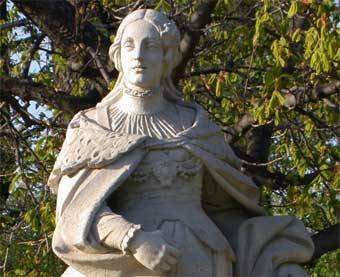
El verdadero dominador de la situación era el ya obispo de Santiago, quien, con la ayuda del conde de Traba, impulsaba cada vez más la autonomía del reino de Galicia, esgrimiendo a Alfonso como baluarte, pues sabía que la reina jamás iría en contra de su hijo. Claro que, desde la perspectiva de la reina, eran dos cosas distintas. En una de sus muchas demostraciones de carácter, y cuando peor parecían marcharle las cosas, por dos veces Urraca entró en Santiago de Compostela para prender al obispo y por dos veces éste se escapó, pero no se pudo evitar que la discordia civil se encendiese de nuevo.
Ante los recurrentes desmanes cometidos por el ejército comandado por Pedro de Lara, Gelmírez recurrió a la ayuda de Teresa de Portugal, que le envió tropas para que sitiasen a Urraca en el castillo de Sobroso, fronterizo con Portugal. A su vez, Urraca logró que se uniesen a su causa los habitantes de Santiago de Compostela, hartos del gobierno despótico de Gelmírez. El caso es que las guerras asolaban otra vez Galicia y en el horizonte no se veía una solución inminente, a pesar de que Urraca y Gelmírez firmaron una especie de tregua en Tierra de Campos a principios de 1117.
El golpe de gracia lo dio tal vez el personaje más férreo y clarividente de una época en que tales valores no parecían demasiado abundantes: Pedro Froilaz, el conde de Traba. Éste se hallaba junto al ya adolescente Alfonso en Toledo, donde el futuro rey velaba sus primeras armas contra los musulmanes. Enterado de las noticias que venían del norte, el conde resolvió llevar a Alfonso a Galicia, donde el joven príncipe expuso sus derechos a la corona de Galicia y a la de Castilla, instando a su madre a la concordia. Así, en mayo de 1117, Gelmírez y Urraca firmaron el llamado pacto del Tambre, que puso fin a los conflictos bélicos y que, de manera más que evidente, consolidó el futuro de Alfonso en el trono castellano.
Resulta complejo el determinar, aun con el paso de los tiempos, cuáles fueron las motivaciones que impulsaron a doña Urraca en sus últimos años para continuar en la brecha bélica, sobre todo con la cuestión de Santiago de Compostela. Uno de los hitos de su vida tuvo lugar el mismo año de 1117, durante nuevas conversaciones entre reina y obispo en la capital jacobea que derivaron en motín. Urraca y Gelmírez tuvieron que refugiarse en la torre del palacio episcopal, pues los insurrectos habían prendido fuego a la catedral en busca de venganza.
Cuando por fin el populacho halló el escondite de reina y obispo, las reacciones de ambos bastan para situar a cada uno en el lugar que le corresponde: Gelmírez arrancó la capa a un pobre vagabundo y escapó embozado, trepando por los tejados de la ciudad hasta refugiarse en la iglesia de Santa María. La reina Urraca fue violentamente atacada y despojada de sus ropas; pero aun así, en paños menores, plantó cara a los amotinados y les conminó a que expusiesen sus quejas, ayudando con ello a calmar la violenta situación. Finalmente, accedió a relevar a Gelmírez como señor jurisdiccional de la ciudad y a reponer la justicia. Incluso en tales circunstancias vergonzantes, una reina debía comportarse como una reina.
Tal vez otra muestra más de carácter sea el que no cumplió nada de lo prometido, sino que, con la ayuda del conde de Traba, llevó a cabo una violenta represión contra quienes habían protagonizado el motín. Eso sí: jamás perdonó a Gelmírez y, de hecho, sus últimos años se caracterizaron por el respeto a la figura de su hijo, a todas luces el personaje dominante tras una época confusa (Pedro de Lara también había fallecido ya), pero también por continuar con la implacable persecución contra el obispo compostelano, al que llegó a hacer prisionero en 1121. Pero para entonces las cosas habían cambiado y Gelmírez se había ganado la simpatía de los compostelanos por haber organizado la exitosa defensa de las costas gallegas del año anterior, en la que repelió un ataque de piratas almorávides.
Para frenar las ansias de su madre contra el arzobispo (historia truculenta donde las haya), Alfonso, a la sazón un joven ya de veinte años, se armó caballero en la catedral de Santiago en 1124, ceremonia que significó la retirada de la escena política de Urraca, para alivio de Gelmírez. La indómita reina castellana falleció en Saldaña, el 8 de marzo de 1126, y su hijo heredó sin mayor problema el reino de Castilla y León.
1 note
·
View note
Photo
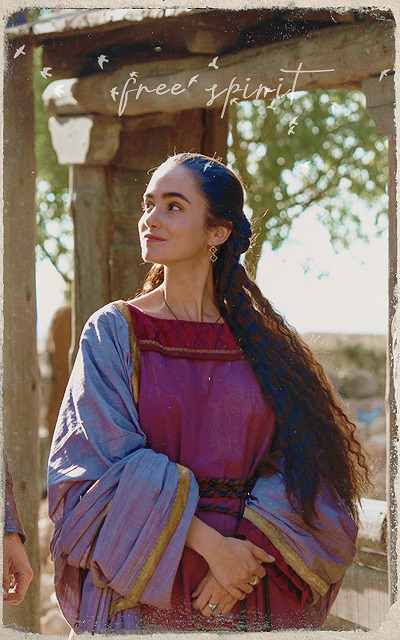
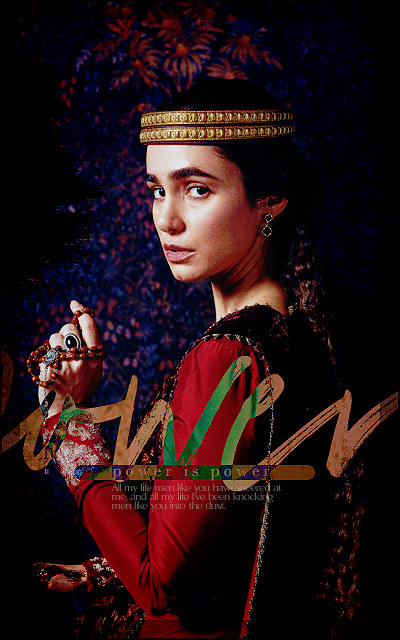
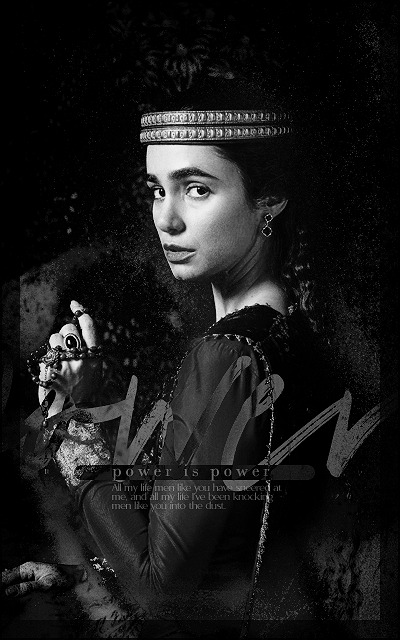
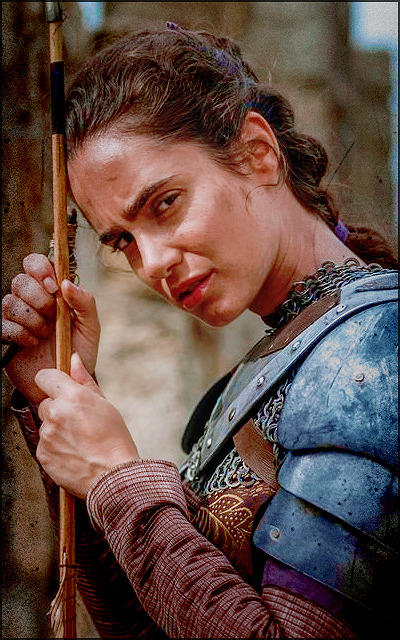
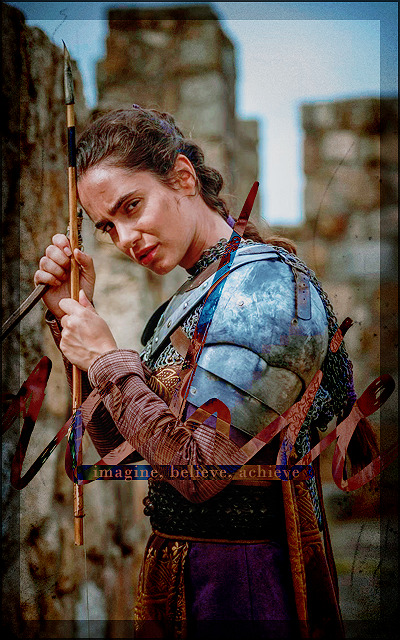

Alicia Sanz as Infanta Urraca (El Cid)
#alicia sanz#alicia sanz avatars#el cid#el cid 2020#urraca de zamora#urraca#infanta urraca#avatars historiques#period fc#perioddramaedit#perioddramacentral#weloveperioddrama#userperioddrama#avatars#avatars 400x640#ressources avatars
54 notes
·
View notes
Text
1st King of Portugal and of the Burgundy Dynasty: King Afonso I of Portugal, “The Conqueror”

Reign: 26 July 1139 – 6 December 1185
Acclamation: 26 July 1139
Successor: Sancho I
Afonso I (25 July 1109 / August 1109 / 1111 – 6 December 1185), nicknamed the Conqueror (: O Conquistador), the Founder (O Fundador) or the Great (O Grande) by the Portuguese, and El-Bortukali ("the Portuguese") and Ibn-Arrink or Ibn Arrinq ("son of Henry", "Henriques") by the Moors whom he fought, was the first King of Portugal. He achieved the independence of the County of Portugal, establishing a new kingdom and doubling its area with the Reconquista, an objective that he pursued until his death.
Henry and Teresa reigned jointly as count and countess of Portugal until his death on 22 May 1112 during the siege of Astorga,after which Teresa ruled Portugal alone. She would proclaim herself queen (a claim recognized by Pope Paschal II in 1116) but was captured and forced to reaffirm her vassalage to her half-sister, Urraca of León. In 1122, Afonso turned fourteen, the adult age in the 12th century. After the military campaign of Alfonso VII against his mother in 1127, Afonso revolted against her and proceeded to take control of the county from its queen.
In 1128, near Guimarães at the Battle of São Mamede, Afonso and his supporters overcame troops under both his mother and her lover, Count Fernando Peres de Trava of Galicia. Afonso exiled his mother to Galicia, and took over rule of the County of Portucale. Thus the possibility of re-incorporating Portucale into a Kingdom of Portugal and Galicia as before was eliminated and Afonso became sole ruler following demands for greater independence from the county's church and nobles. The battle was mostly ignored by the Leonese suzerain who was occupied at the time with a revolt in Castille. He was also, most likely, waiting for the reaction of the Galician families. After Teresa's death in 1131, Afonso VII of León and Castille proceeded to demand vassalage from his cousin. On 6 April 1129, Afonso Henriques dictated the writ in which he proclaimed himself Prince of Portugal or Prince of the Portuguese, an act informally allowed by Afonso VII, as it was thought to be Afonso Henriques's right by blood, as one of two grandsons of the Emperor of Hispania. Afonso then turned his arms against the persistent problem of the Moors in the south. His campaigns were successful and, on 25 July 1139, he obtained an overwhelming victory in the Battle of Ourique, and straight after was (possibly unanimously) proclaimed King of the Portuguese by his soldiers, establishing his equality in rank to the other realms of the Peninsula, although the first reference to his royal title dates from 1140.

The first assembly of the Portuguese Cortes convened at Lamego (wherein he would have been given the crown from the Archbishop of Braga, to confirm his independence) is a 17th-century embellishment of Portuguese history.
Complete independence from Alfonso VII of León's suzerainty, however, was not a thing he just could achieve militarily. The County of Portugal still had to be acknowledged diplomatically by the neighboring lands as a kingdom and, most importantly, by the Catholic Church and the Pope. Afonso wed Mafalda of Savoy, daughter of Amadeus III, Count of Savoy, and sent ambassadors to Rome to negotiate with the Pope. He succeeded in renouncing the suzerainty of his cousin, Alfonso VII of León, becoming instead a vassal of the papacy, as the kings of Sicily and Aragon had done before him.
In Portugal he built several monasteries and convents and bestowed important privileges to religious orders. He is notably the builder of Alcobaça Monastery, to which he called the Cistercian Order of his uncle Bernard of Clairvaux of Burgundy.


In 1143, he wrote to Pope Innocent II to declare himself and the kingdom servants of the church, swearing to pursue driving the Moors out of the Iberian Peninsula. Bypassing any king of León, Afonso declared himself the direct liege man of the papacy. Afonso continued to distinguish himself by his exploits against the Moors, from whom he wrested Santarém

and Lisbon in 1147.

He also conquered an important part of the land south of the Tagus River, although this was lost again to the Moors in the following years.
Meanwhile, King Alfonso VII of León (Afonso's cousin) regarded the independent ruler of Portugal as nothing but a rebel. Conflict between the two was constant and bitter in the following years. Afonso became involved in a war, taking the side of the Aragonese king, an enemy of Castile. To ensure the alliance, his son Sancho was engaged to Dulce, sister of the Count of Barcelona and Infanta of Aragon. Finally after winning the Battle of Valdevez,

the Treaty of Zamora (1143) established peace between the cousins and the recognition by the Kingdom of León that Portugal was a fully independent kingdom.

In 1169 the now old Dom Afonso was possibly disabled in an engagement near Badajoz, by a fall from his horse and slamming against the castles gate, and made prisoner by the soldiers of the king of León Fernando II also his son-in-law. He spent months at the hot springs of São Pedro do Sul, but never recovered and from this time onward the Portuguese king never rode a horse again.
In 1179 the privileges and favours given to the Catholic Church were compensated. With consistent effort by several parties, such as the Primate Archpishop of Braga Paio Mendes, in the papal court, the papal bull Manifestis Probatum was promulgated accepting the new king as vassal to the pope exclusively. In it Pope Alexander III also acknowledged Afonso as King and Portugal as an independent crown with the right to conquer lands from the Moors. With this papal blessing, Portugal was at last secured as a kingdom.
In 1184, the Almohad caliph Abu Yaqub Yusuf rallied a great Almohad force to retaliate against the Portuguese raids done since the end of a five-year truce in 1178 and besieged Santarém, which was defended by the heir Sancho. The Almohad siege failed when news arrived the archbishop of Compostela had come to the defense of the city and Fernando II of León himself with his army. The Almohads ended the siege and their retreat turned into a rout due to panic in their camp, with the Almohad caliph being injured in the process and dying on the way back to Seville. Afonso died shortly after, probably out of a sudden cause of death, on 6 December 1185. The Portuguese revere him as a hero, both on account of his personal character and as the founder of their nation.

He rest in the Monastery of Santa Cruz in Coimbra:
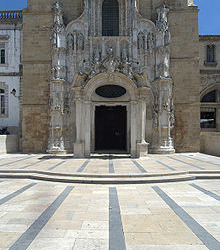

In 1146, Afonso married Mafalda, daughter of Amadeus III, Count of Savoy and Mahaut of Albon, both appearing together for the first time in May of that year confirming royal charters. They had the following issue:
Henrique (5 March 1147 – 1155 named after his paternal grandfather, Henry, Count of Portugal, he died when he was only eight years old. Despite being just a child he represented his father at a council in Toledo at the age of three;
Urraca (1148–1211), married King Ferdinand II of León and was the mother of King Alfonso IX. The marriage was subsequently annulled in 1171 or 1172 and she retired in Zamora, one of the villas that she had received as part of her arras, and later at the Monastery of Santa María in Wamba, Valladolid where she was buried.;
Teresa (1151–1218), Countess consort of Flanders due to her marriage to Philip I and Duchess consort of Burgundy through her second marriage to Odo III;
Mafalda (1153 – after 1162). In January 1160, her father and Ramón Berenguer IV, Count of Barcelona, negotiated the marriage of Mafalda to Afonso, future King Alfonso II of Aragon who at that time was three or four years old. After the death of Ramón Berenguer IV in the summer of 1162, King Ferdinand II of León convinced his widow, Queen Petronilla, to cancel the infante's wedding plans with Mafalda and for Afonso to marry instead Sancha, daughter of Alfonso VII of León and his second wife Queen Richeza of Poland. Mafalda died in her childhood at an unrecorded date.
Sancho, the future King Sancho I of Portugal (11 November 1154 – 26 March 1211). He was baptized with the name of Martinho for having been born on the saint's feast day.;
João (1156–25 August 1164);
Sancha (1157–14 February 1166/67), born ten days before the death of her mother, Sancha died before reaching the age of ten on 14 February according to the death registry at the Monastery of Santa Cruz (Coimbra) where she was buried.
Before his marriage to Mafalda, King Afonso fathered his first son with Chamoa Gómez, daughter of Count Gómez Núñez and Elvira Pérez, sister of Fernando and Bermudo Pérez de Traba:
Afonso (1140–1207). Born around 1140,according to recent investigations, he is the same person as the one often called Fernando Afonso who was the alferes-mor of the king and later Grand Master of the Knights Hospitaller. His presence in the court is first recorded in 1159. In 1169 he succeeded as alferes-mor his half-brother, Pedro Pais da Maia, the legitimate son of his mother and Paio Soares da Maia.
The extramarital offspring by Elvira Gálter were:
Urraca Afonso. In 1185, her father gave her Avô, stipulating that this villa was to be inherited only by the children that she had with her husband Pedro Afonso de Ribadouro (also known as Pedro Afonso Viegas), grandson of Egas Moniz, which could indicate another previous or subsequent marriage. In 1187, she exchanged with her half-brother, King Sancho, this villa for Aveiro. She died after 1216, the year she made a donation to the Monastery of Tarouca.
Teresa Afonso. In some genealogies she appears as the daughter of Elvira Gálter, and in others as the daughter of Chamoa Gómez. Her first marriage was with Sancho Nunes de Barbosa with whom she had a daughter, Urraca Sanches, who married Gonçalo Mendes de Sousa, the father of Mendo Gonçalves de Sousa known as "Sousão".Her second husband was Fernando Martins Bravo, Lord of Bragança and Chaves, with no issue from this marriage.
King Afonso was also the father of:
Pedro Afonso (died after 1183), Lord of Arega and Pedrógão, mayor of Abrantes in 1179, alferes of King Afonso I between 1181 and 1183, and Master of the Order of Aviz.
27 notes
·
View notes
Link
In their newly published book “Los Reyes del Grial” (“The Kings of the Grail”), medieval history lecturer Margarita Torres and art historian José Miguel Ortega del Rio claim the Holy Grail rests inside the Basilica of San Isidoro in the northern Spanish city of León. The historians say that a three-year investigation led to their conclusion that the hallowed cup that Jesus Christ supposedly drank from at the Last Supper and that was used to collect his precious blood is a jewel-encrusted goblet that has long been known as the chalice of the Infanta Doña Urraca in honor of the daughter of King Ferdinand I, ruler of León and Castile from 1037 to 1065.
3 notes
·
View notes
Photo

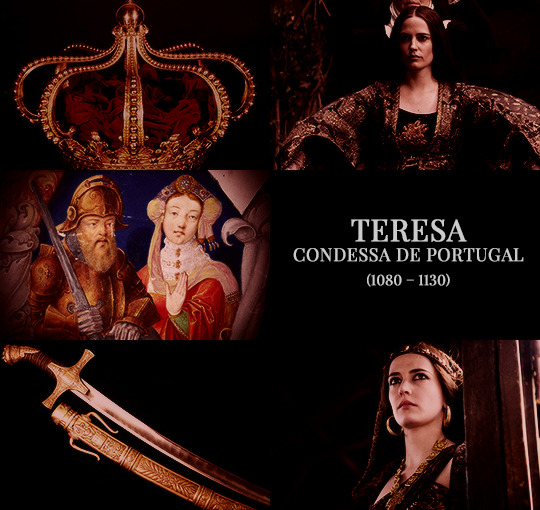




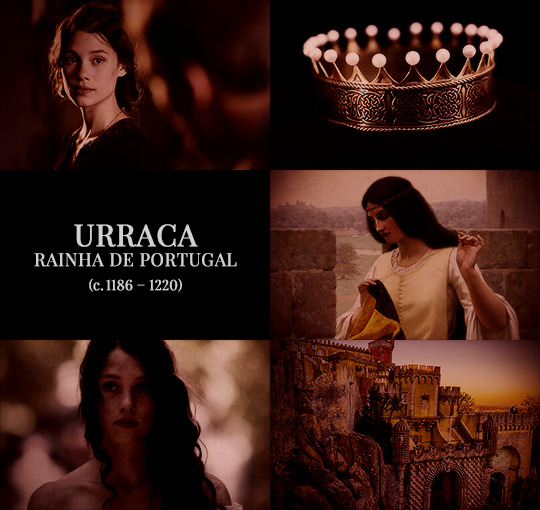
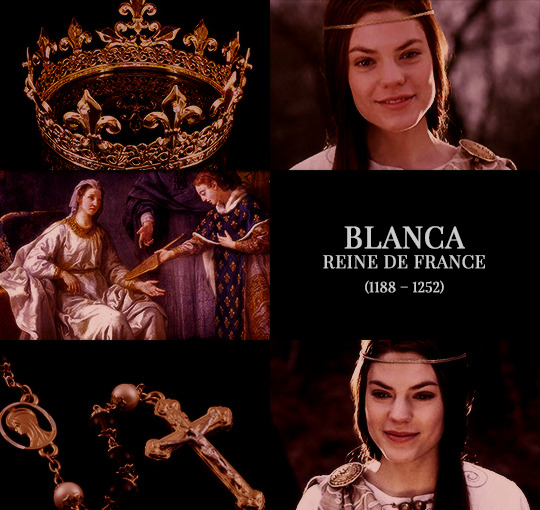

Castilian Infantas aesthetic, part I
Elvira, comtessa de Tolosa. Daughter of Alfonso VI de Castilla and Jimena Muñoz.
Teresa, condessa de Portugal. Daughter of Alfonso VI de Castilla and Jimena Muñoz.
Elvira, Regina di Sicilia. Daughter of Alfonso VI de Castilla and Zaida de Sevilla.
Constanza, reine des Francs. Daughter of Alfonso VII and Berenguera de Barcelona. Mother of Marguerite de France, Queen of England and Alais de France, comtesse du Vexin.
Sancha, Nafarroako erregina. Daughter of Alfonso VII and Berenguera de Barcelona. Mother of Berengela Nafarroakoa, Queen of England and Zuria Nafarroakoa, comtesse de Champagne.
Sancha, reina d��Aragó. Daughter of Alfonso VII and Ryksa Polska. Mother of Constança d’Aragó, Sacri Romani Imperatrix; Leonor d’Aragó, comtessa de Tolosa; and Sancha d’Aragó, comtessa de Tolosa. Grandmother of Joana de Tolosa.
Urraca, rainha de Portugal. Daughter of Alfonso VIII and Eleanor of England. Mother of Leonor de Portugal, Dronning af Danmark.
Blanca, reine de France. Daughter of Alfonso VIII and Eleanor of England. Mother of Saint Isabelle de France.
Berenguela, Latin Empress of Constantinople. Daughter of Berenguela I and Alfonso IX de León. Mother of Marie de Brienne, Latin Empress of Constantinople.
#house of jimenez#medieval#house of ivrea#historyedit#spanish history#european history#women's history#history#nanshe's graphics#royalty aesthetic
195 notes
·
View notes
Text




"El Cid " (2020) :
Infante Alfonso (future Alfonso VI of Leon)
Infanta Urraca (Urraca of Zamora)
40 notes
·
View notes
Photo

🏛Museum Week! 👆Today we share one of the most curious artworks acquired by the State to Balclis: a small sepulcher or sarcophagus of an "infanta" of Aragon, from 12th century. It is believed that it was made for the remains of a 4-year-old girl (due to its size), probably for the Infanta Urraca de Aragón, who died in the monastery. Another theory says that the remains were of Teresa, Countess of Provenza, which would be the new possessor of those states, and sister of the previous one. After being in different locations, ecclesiastical and private, this work, very important for the Aragonese heritage, was deposited in the collections of the Huesca Museum in 2011, finding its origin again. (en Museo de Huesca) https://www.instagram.com/p/BwJ-9X-FY6p/?utm_source=ig_tumblr_share&igshid=10sfwat542dlk
17 notes
·
View notes
Text

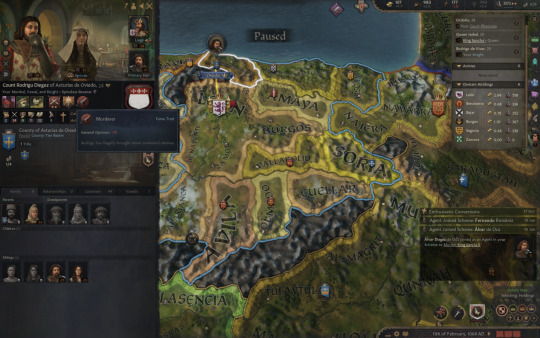
I present to you shocking news... Alfonso's sister, steward and lover, Infanta Urraca Fernandez of Castille (and the Countess of Zamora) was murdered by Count Rodrigu Diegez of Asturias de Oviedo, Alfonso's Marshal, Vassal and Knight. The reasons why he committed the murder remain unknown.
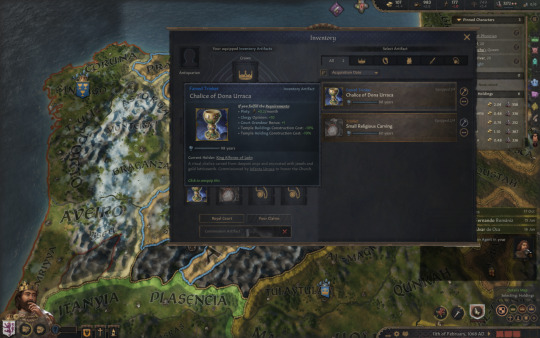
Meanwhile, Alfonso inherited the Chalice of Dona Urraca, gold and a small religious carving from Infanta Urraca which helped make her passing slightly tolerable.
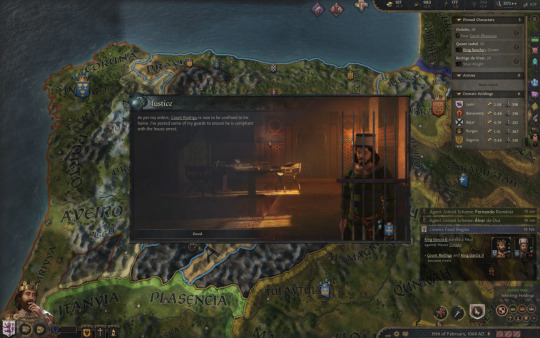
Alfonso successfully imprisoned Count Rodrigu in his own home for the murder.
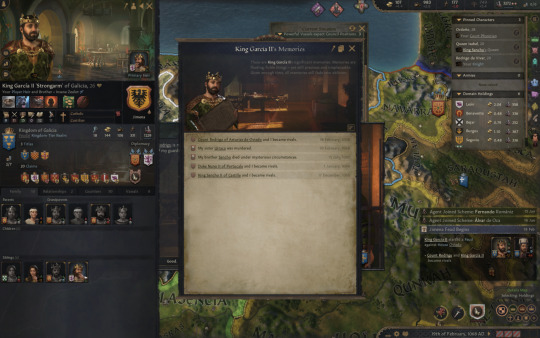
Our brother and house head, King Garcia became rivals with Count Rodrigu and started a house feud between House Jimena and House Oviedo because of the murder.

Alfonso promptly appoint a new steward (Count Munio with 24 stewardship skill) and a new marshal in El Cid with 27 in Marshal skill.


Alfonso became rivals with Rodrigu after stripping him of the county of Asturias de Oviedo. And with that, his former Marshal is no longer anyone of importance.
4 notes
·
View notes
Note
Any ideas on the varying attitudes and bigotry of interracial marriage when it comes to normal common people vs royal diplomatic marriages?
Mod Miri note: Please remember this is a writing advice blog, so please phrase your questions in that context.
Feral: What kingdom? What century or decade? How are we defining "interracial"? Because race as a modern concept really wasn't a thing until like the 15th century. Are we including "interfaith"? What about between ethnic groups that would in modern American/western standards be counted as same race?
And also, whose attitudes? The common person's, the aristocrat's, the monarch's? Do you want to know what the specific laws were?
Unfortunately, this question is too vague to answer properly. You've asked for the whole of human history across the globe. It varies. A lot. Way too much to do it justice.
Tex: Feral brings up several excellent points - the language you're using is tilted toward vagueness and a given perception which I'm not sure if you're wanting us to match, since we're here to try and give impartial knowledge.
I will say that marriage as a concept is a very deep topic, where just looking at its cultural value and significance strictly in the very modern day is enough to write several essays on, much less sticking to one area and even less so including historical changes for any given time period.
If you would like to come back with the specific information you're looking for, such as region, time frame, social strata, etc, we'd be glad to help you.
Werew: Also, if you are working with a completely made up culture, we'd be happy to help you critique/expand your ideas, if you can give us a description of the culture and/or what marriage views you have in mind. We're happy to help you brainstorm a bit, we just need some more to build from than this!
Constablewrites: This is a situation where looking to the real world can help. Depending on the time period/culture you're working from (whether writing directly in that setting or using them as inspiration), you can probably find a good deal of information about their marriage customs, marriage for politics vs marriage for love, people who were discouraged (or flat-out forbidden) from getting married, that sort of thing.
Feral: For an example on why it is so important we have more information on the when and where you're looking, let's take a look at King Afonso III of Portugal and his mistress Madragana in the mid-13th century.
Madragana may have been black (this was kinda before the invention of race so it's hard to tell); she was definitely born to an Iberian Muslim family before she converted (likely via coercion) to Christianity. Eventually she became the mistress of the king (also her godfather, ew); now, this was not a marriage, but the children she bore to Afonso were known to be his and were part of the court. Her son Martim had a noble title and was a member of his half-brother's, King Denis of Portugal's, court. There seems to be no real issue about Martim's or his sister Urraca's (who was legit styled "infanta" (aka called a princess)) race.
Until 500 years later when Charlotte of Mecklenburg-Strelitz (a German woman) married George III of England. From their 1761 wedding, Queen Charlotte has been rumored to be the descendant of Afonso and Madragana. And this was a really big deal in late 18th century England and its colonies. Now, how the much the common person knew about this rumor, we couldn't begin to speculate though she is often noted as "looking mulatto" (whatever that means), but we do know that she became a poster child, quite literally, for the abolitionist movement. Google "Allan Ramsay portrait of Queen Charlotte." Some 15 generations removed from a woman who might have been black, and Ramsay depicted Charlotte with darker skin, natural hair, and a wider, flat nose, basically saying that "hey our queen is of African descent! we should free all those slaves who are of African descent!"
200+ years later, Harry, Queen Charlotte's great^5-grandson, married Meghan. Reactions have been... varied. Both among the common folk and the Queen's relations (coughprincessmichaelofkentcough).
20 notes
·
View notes
Photo
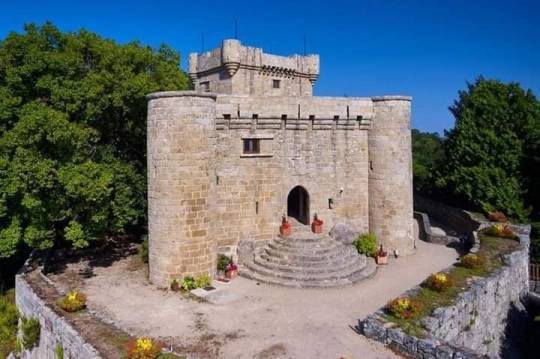
Castillo de Sobroso, Pontevedra. Antiguamente llamado "Soveroso" por las sobreiras o alcornoques que existían en el entorno, está situado en un promontorio rocoso en la ladera del Monte Landín, a 334 metros sobre el nivel del mar. La primera noticia del Castillo de Sobroso nos la facilita la "Historia Compostelana", fuente histórica de gran importancia durante el s. XII. Se refiere a la noticia de que la reina Doña Urraca fue sitiada por algún tiempo en esta fortificación por su hermana Doña Teresa, infanta de Portugal, y su hijo Alfonso VII en 1117. Finalmente huyó a Compostela en busca del auxilio del Arzobispo Gelmírez. El castillo fue prácticamente destruido en el 1467 durante las Guerras Irmandiñas y posteriormente reconstruido en el siglo XV por Pedro Madruga. Paulatinamente su importancia estratégica se fue reduciendo y a partir del siglo XVII quedó abandonado, arruinándose con el paso de los años. En 1923 es adquirido por Alejo Carrera Muñoz, un vecino de Villasobroso, que se dedica a la restauración de este monumento. Posteriormente el ayuntamiento de Puenteareas lo compró en 1981 a sus herederos para terminar de restaurarlo y crear en él un museo histórico y etnográfico de la comarca del Condado. El castillo está compuesto en la actualidad por tres elementos: una cerca exterior, que mantiene en algún tramo el trazado primitivo del siglo XII con un perímetro muy ceñido al edificio, que deja poco espacio para la guarnición, el cuerpo residencial con dos plantas, la baja puesta para albergar el cuerpo de guardia con sus tronas defensivas y la torre del homenaje, que protege, con sus 13 m, el único flanco por el que el castillo pudiese ser atacado. Conforman un conjunto que resulta imponente desde el exterior por sus tres estructuras de diferentes alturas y sobrepuestas unas a las otras. #galicia #castillosgalicia #Spain #VisitSpain #SpanishinSpain #LearnSpanish #SpanishinUbeda #Castles (en Castillo de Sobroso) https://www.instagram.com/p/CW01sAPt4mj/?utm_medium=tumblr
0 notes